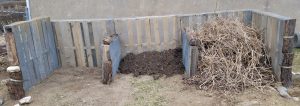What is Composting?
Composting is the process of breaking down organic material into nutrient-rich soils.
What Can Be Composted?
In short, anything that was recently living. Leaves, kitchen scraps, hedge and grass clippings, wood chips, egg shells, etc. Even meat and bones can be composted, though if not done properly it can develop a funky smell and attract unwanted scavengers.
Why Should We Compost?
Composting allows us to take things that would otherwise be trash and turn them into valuable soils. It lessens our contribution to landfills and provides us with high-quality fertilizer without the use of fossil fuels. Making compost on site means less transportation of materials, and it allows us to capture the energy in these materials and store them in the form of soil.
Adding compost to garden beds not only provides plants with key nutrients they need to grow, making them more nutritious to eat, but it can also help manage pest and disease.
How to Compost
Composting is an easy and fun way to connect with the ecosystem and the food we eat. The first step is to create a dedicated composting space. Having all the composting materials together allows the microbes and soil organisms to feed off each other’s heat and will keep the pile decomposing even into the cold winter months. The easiest and least expensive way to make a compost pile is to use up-cycled shipping pallets and a few galvanized steel brackets to hold them together. GrowVeg has a great youtube video on how to do this. Pallets can usually be source for free from the loading docks of grocery stores and shipping centers. There are also all kinds of fancy compost barrels and tumblers available on the market, but those are usually expensive and made of plastic, and in our experience don’t even work as well as the simple pallet design.

Once the location is set up, it’s time to add materials!
To get good compost, it’s important to get the balance of carbon and nitrogen right. Once a pile is established, it tends to be pretty forgiving, but understanding the compost chemistry and ecology can help with diagnosing problems and getting the best compost possible.
Materials for composting are divided into two categories: Browns, which are high in carbon, and Greens, which are high in nitrogen. It may be a little confusing, but just because something is green in color doesn’t mean it is a green as far as composting is concerned, and vice versa. Browns are things like leaves, wood, and paper towels, while greens are things like vegetable scraps, coffee grounds, and grass clippings. The ideal carbon to nitrogen ratio is 30:1, which can be achieved by mixing roughly half greens and half browns by weight.
| Browns | Carbons per Nitrogen | Greens | Carbons per Nitrogen |
|---|---|---|---|
| Paper Towels | 800 | Urine* | 0.8 |
| Sawdust/wood chips | 500 | Manure | 18 |
| Straw | 80 | Grass Clippings | 17 |
| Leaves | 40 | Bone meal | 3.5 |
| Newspaper | 800 | Vegetable Scraps | 12 |
| Coffee Grounds | 20 | ||
*Note that urine also contains high levels of salt
Don’t worry too much about the C:N ratio quantitatively, we’ve never sat at a pile with a calculator to to determine the exact ratio, but know the signs of too much or too little nitrogen so you can adjust accordingly.
If a pile is slimy, smelly, and/or has maggots wriggling in it, it probably has too much nitrogen. Try adding high-carbon materials like wood chips or leaves and giving it a good turning to mix and aerate the pile.
If a pile is dry, moldy, and/or cold, it probably needs more nitrogen. Try adding high-nitrogen materials like vegetable scraps or grass clippings.
It’s also important to turn the pile regularly. This allows oxygen to get into the pile to promote healthy decomposition and also ensures that materials on the outside get mixed in so everything decomposes uniformly. Turning also deters rodents from making their homes in the pile. Turning once per week is recommended.
Adding some soil can be very helpful when starting a new pile, as it provides the right microbes for decomposition. Alternatively, a new pile can be seeded with material from an established compost pile.
The last thing is to remember to Observa e interactúa with the pile! See how it responds to being turned and to additions of different materials. Watch as it pulses year after year with the seasons, going down to rest in the fall and waking up in the spring. Follow the path of nutrients from the kitchen scraps to the compost pile to the garden and back into the kitchen. Feel yourself becoming a part of the cycle of life.
And that’s really all there is to it. So what are you waiting for? Start today!